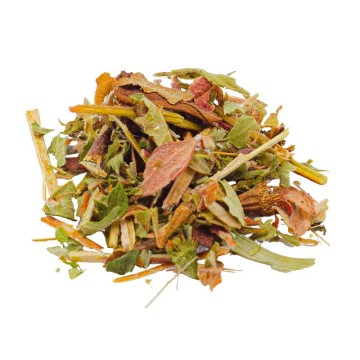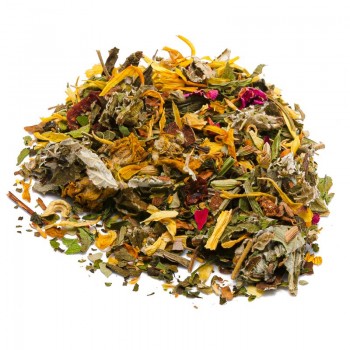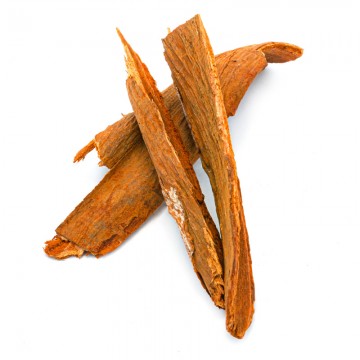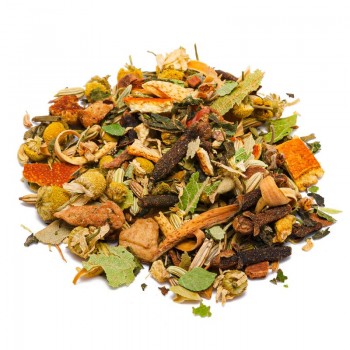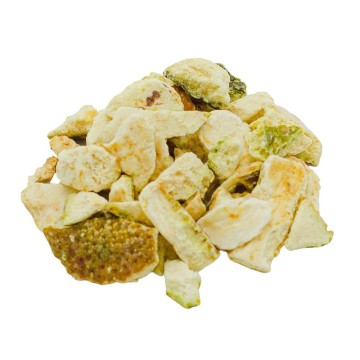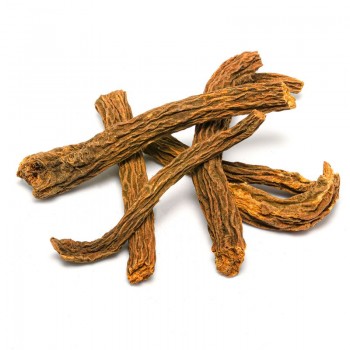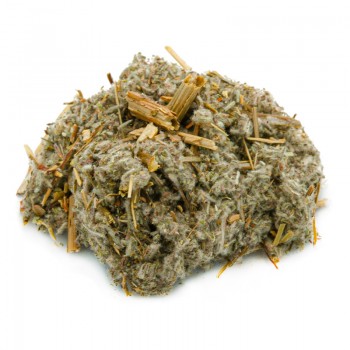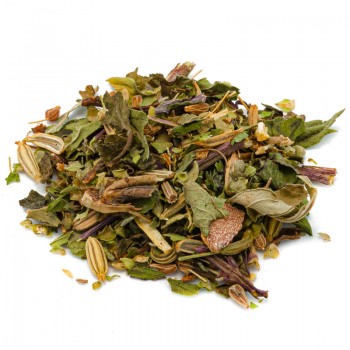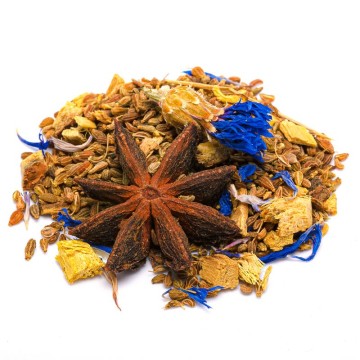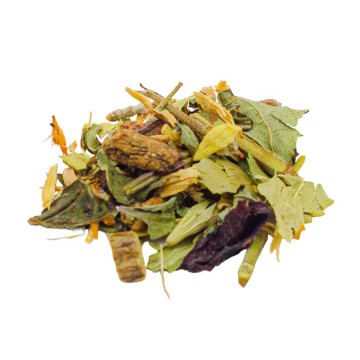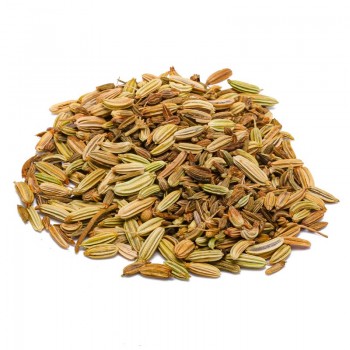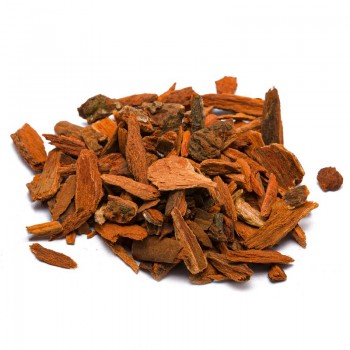This plant uses the famous root, which contains active ingredients that promote digestion, with tonic and purifying properties.
For these reasons, it has been used for centuries throughout Europe for medicine and liquor preparations.
With this cut for the herbal tea, the gentian root is used not only for the gentian liqueur, but also for healthy infusions , and for the its bitter taste, ideal as a digestive .
Gentian Root: properties and benefits
The root of the gentian plant has a special taste and features useful for our health.
The roots contain the substance of gentiopicrin, which gives the herbal tea a bitter taste and defines the medicinal properties of the plant.
Gentiopicrin is a glucosidic compound (a sugar that joins the aglycone component), formerly known as an antimalarial substance.
Today gentian is appreciated for its eupeptic properties, that is, they facilitate digestion and stimulate the appetite. A gift present both in liqueurs and in herbal teas with gentian root. Both show a bitter taste.
The herbal tea with gentian root can be drunk after meals but also before, as an aperitif , to prepare digestion, avoiding the formation of air and intestinal gas.
An artisan amaro or gentian liqueur, on the other hand, is perfect after a meal to overcome digestive difficulties.
The plant is known as a tonic-stomachic (improves stomach muscle tone), counteracts inflammation during digestive transit, and is useful against heartburn.
Gentian root is also excellent for soothing irritation of the esophagus due to stomach acids. As a natural remedy , it acts on the symptoms of acid reflux by joining a healthy diet.
In addition, the herbal tea from gentian roots is suitable for calming the symptoms of certain digestive disorders such as bloating, intestinal gas, constipation, heaviness during digestion and other gastrointestinal problems.
An herbal tea with gentian roots effectively stimulates the digestive system, making it easier for the body to absorb essential substances such as iron.
Together with other minerals and other substances, the already mentioned gentian gives the gentian cholagogue characteristics, that is, beneficial for the well-being of the liver. The herbal tea has purifying qualities that help eliminate toxins.
Gentian roots also allow you to consume an antioxidant herbal tea, rich in important minerals such as iron and zinc.
Origins and History of cultivation
Gentiana lutea L. has been known for centuries among European populations also as yellow gentian, gallic grass or bitter root.
It is a herb with beneficial roots, discovered by the inhabitants of the alpine regions of central and southern Europe, the regions where it grows spontaneously.
Many people also use gentian for the beauty of the plant, which enhances gardens and green spaces.
According to tradition, its name derives from a lover of ancient herbs, Gentius, the last king of the Illyrians in the 2nd century BC. According to the Roman historian Pliny, it was he who discovered antimalarial properties of gentian roots, and one of the first to use them outdoors to heal wounds, as well as as an antidote for snake bites and some poisons.
The root infusion could be used on the skin to treat lesions and sanitize as a natural antiseptic.
Also in ancient times, its most effective properties were already noted: improving digestion and regulating the flow of bile. Gentian was known to stimulate saliva and stomach acids, as an aperitif or digestive.
Gentian herbs were used by ancient Romans, Greeks and Egyptians as a digestive tonic and to eliminate intestinal worms.
It was also considered an effective plant for the relaxing effect on the nervous system.
In ancient times it was used to calm people I knowthey suffered from anxiety, agitation, hysteria, childhood convulsions or fever.
It was used in the treatment of malaria in place of quinine, and a Hungarian legend speaks of it as a remedy against the plague in the time of King Ladislao. These properties derive from the active ingredient gentiopicroside, which stimulates the production of white blood cells.
When combined with other herbs, gentian could treat headaches and bitter mouth tastes. In this regard, the mountain populations used to chew a piece of root every day, to keep themselves healthy and prolong their life.
Due to the digestive benefits and their unmistakable taste, the roots are still collected and sold in different parts of the world today. In particular, in America and Asia, where gentian is used for medicinal purposes.
Plant and flowers
Gentiana lutea L. is a herbaceous plant belonging to the Gentianaceae, which includes about 180 species. The word lutea derives from lúteus, yellow in color.
The gentian plant grows to about two meters high, with elliptical leaves and yellow flowers.
It develops best in meadows and pastures with little humidity, on calcareous soils, rich in organic substances. It prefers soils in full sun.
The greater gentian reaches maturity towards the fifth year, so the crop is multi-year but with only one harvest.
We find it spontaneously up to over 2000 meters high, in the mountainous areas of central and southern Europe. In Italy it is present in almost the entire Alpine arc, and in the central-southern Apennines.
It is a rare species, and for this reason it is a protected plant in Italy.
The root is used in medicine and in liquor, and specimens of at least two years old are used. It can be left whole, or in the case of the herbal tea cut root, it is cut into pieces and left to dry in the sun. Thus it takes on reddish-brown shades.
Nutritional values of Gentian root
The roots of gentian are rich in sugars, enzymes, vitamin F and vitamin B; in addition to other elements such as alkaloids, iridoid glycosides and secoiridoids.
These are substances such as inositol, gentiopicrin, gentisin, and amelogenin, which make its taste bitter and give gentian its medicinal properties.
The roots of gentian herb also contain essential minerals such as iron, sulfur, manganese, silicon and zinc.
The chemical constituent extracted in purity, amarogentina, has an absolute bitter value higher than many other plants.
How to consume Gentian root in the kitchen
The most used part of the plant is the root, which is harvested for the production of aromatic liqueurs and wines.
In addition, the gentian root in herbal tea cut, allows you to create a beneficial infusion for digestion.
For the herbal tea we recommend about 2 grams of gentian root for each cup of boiling water (about 250 ml). Leave to infuse for a few minutes (5-7) according to the intensity of the desired flavor. For those who want to create a good gentian liqueur, here are some suggestions for preparation.
Liqueur recipe: 100 g of whole root gentian, 4 liters of white wine, 1 kg sugar, 1 liter of alcohol.
The typical recipe calls for a maceration of the dried gentian roots in white wine for at least 40 days in a container. The wine must be acid white but not too aromatic. Subsequently, the roots must be removed from the container, adding alcohol and sugar.
There is no need to filter the liquid, since the gentian roots release few impurities, which settle on the bottom.
By using these broken roots, the release of bitter substances occurs more slowly, and the fragrant and spicy notes are lighter, which soften the liqueur.
Those who want a more bitter liqueur can decrease the amount of sugar. Those who want to flavor can add a lemon zest, 2 bay leaves, a stick of cinnamon and 3 cloves to the roots.
Recall that the radGentian ice can also be useful to prepare a purifying decoction, or an ancient mountain recipe, by macerating the root in grappa for about a month.
Genziana Root: side effects and contraindications
This plant has well-defined properties on the digestive system, so it is necessary to be careful for people with problems such as ulcers, acute gastritis, esophagitis, hiatal hernia, and chronic gastrointestinal disorders .
Some people who take gentian in herbal tea or as a liqueur may experience side effects such as headache, nausea and vomiting, especially in excessive quantities.
Herbal tea and gentian liqueur are not recommended for pregnant or breastfeeding women.
To find out about all the pharmacological treatments that can interact with gentian roots, medical advice is recommended.

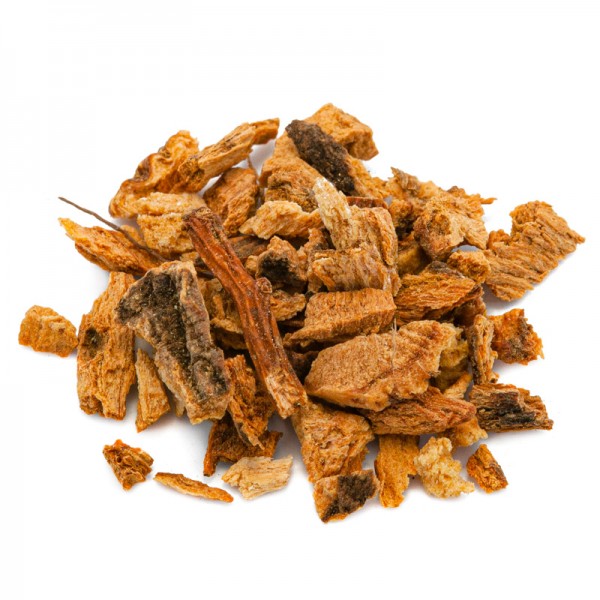









 No reward points for this product.
No reward points for this product.
